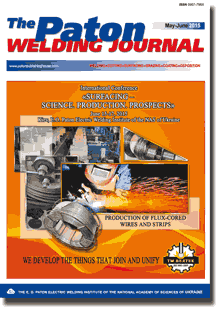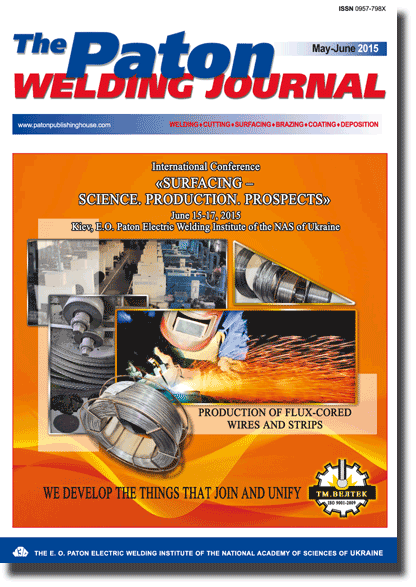| 2015 №06 (07) |
DOI of Article 10.15407/tpwj2015.06.08 |
2015 №06 (09) |

The Paton Welding Journal, 2015, #5-6, 37-40 pages
Improvement of bimetal joint quality in submerged arc surfacing of high-tin bronze on steel
T.B. Majdanchuk, V.M. Ilyushenko And A.N. Bondarenko
E.O. Paton Electric Welding Institute, NASU. 11 Bozhenko Str., 03680, Kiev, Ukraine. E-mail: office@paton.kiev.ua
Abstract
It was shown that one of the efficient methods for producing bimetal product steel + high-tin bronze is submerged electric arc surfacing applying flux-cored wires. Analyzed were the causes for formation of different defects, which are possible in surfacing of bronze on steel. Considered were technological and metallurgical measures of eliminating porosity both on the deposited metal as well as along the fusion line of bronze with steel. To provide a minimum penetration of steel and reduction of iron content in bronze the process is performed using «split» electrode (two-electrode surfacing) at the optimum modes. The special attention is paid to study of causes for formation of intercrystalline penetrations of bronze into steel and their influence on quality of bimetal joint. The threshold value of energy input is determined at which the tendency to decrease the formation of intercrystalline penetrations is observed. 10 Ref., 2 Tables, 4 Figures.
Keywords: high-tin bronze, submerged arc surfacing, bimetal joint, intercrystalline penetrations
Received: 03.04.15
Published: 28.07.15
References
1. Osintsev, O.E., Fyodorov, V.N. (2004) Copper and copper alloys. Domestic and foreign grades: Refer. Book. Moscow: Mashinostroenie.
2. Ilyushenko, V.M., Lukianchenko, E.P. (2013) Welding and surfacing of copper and copper alloys. Kiev: IAW.
3. Grigorenko, G.M. (1970) To problem of pore formation in welds. Avtomatich. Svarka, 10, 20-29.
4. Pokhodnya, I.K. (1972) Gases in welds. Moscow: Mashinostroenie.
5. Pokhodnya, I.K., Makhnenko, V.I. (1971) On kinetics of pore formation in welds. Avtomatich. Svarka, 7, 20-23.
6. Ilyushenko, V.M., Belov, A.S., Kinovich, A.P. (1985) Efficiency of surfacing of copper alloys on steel with split electrode. In: Surfacing. Experience and efficiency of application, 82-86. Kiev: PWI.
7. Ilyushenko, V.M. (1978) Advanced methods of electric arc surfacing of copper alloys on steel. In: Proc. of 1st All-Union Seminar on Welding and Surfacing of Heavy Nonferrous Metals, 30-32. Kiev: PWI.
8. Vajnerman, A.E., Pichuzhkin, S.A., Chernobaev, S.P. et al. (2012) New welding consumables and technological specifics of welding and surfacing of products of copper alloys and dissimilar metals. In: Proc. of Int. Sci.-Techn. Conf. on Welding Consumables-2012, 141-147.
9. Rybin, V.V., Vajnerman, A.E., Baranov, A.V. at al. (2006) Study of peculiarities and development of welding technologies of copper alloys with steels and surfacing of copper alloys on steel. Voprosy Materialovedeniya, 1, 220-229.
10. Vajnerman, A.E. (1981) Mechanism of intercrystalline penetration in surfacing of copper alloys on steel. Ibid., 6, 22-26.
Suggested Citation
T.B. Majdanchuk, V.M. Ilyushenko And A.N. Bondarenko (2015) Improvement of bimetal joint quality in submerged arc surfacing of high-tin bronze on steel. The Paton Welding J., 06, 37-40.The cost of subscription/purchase order journals or individual articles
| Journal/Currency | Annual Set | 1 issue printed |
1 issue |
one article |
| TPWJ/USD | 384 $ | 32 $ | 26 $ | 13 $ |
| TPWJ/EUR | 348 € | 29 € | 24 € | 12 € |
| TPWJ/UAH | 7200 UAH | 600 UAH | 600 UAH | 280 UAH |
| AS/UAH | 1800 UAH | 300 UAH | 300 UAH | 150 UAH |
| AS/USD | 192 $ | 32 $ | 26 $ | 13 $ |
| AS/EUR | 180 € | 30 € | 25 € | 12 € |
| SEM/UAH | 1200 UAH | 300 UAH | 300 UAH | 150 UAH |
| SEM/USD | 128 $ | 32 $ | 26 $ | 13 $ |
| SEM/EUR | 120 € | 30 € | 25 € | 12 € |
| TDNK/UAH | 1200 UAH | 300 UAH | 300 UAH | 150 UAH |
| TDNK/USD | 128 $ | 32 $ | 26 $ | 13 $ |
| TDNK/EUR | 120 € | 30 € | 25 € | 15 € |
AS = «Automatic Welding» - 6 issues per year;
TPWJ = «PATON WELDING JOURNAL» - 12 issues per year;
SEM = «Electrometallurgy Today» - 4 issues per year;
TDNK = «Technical Diagnostics and Non-Destructive Testing» - 4 issues per year.


